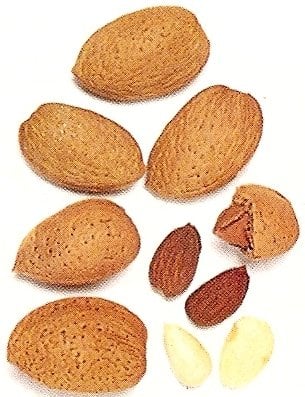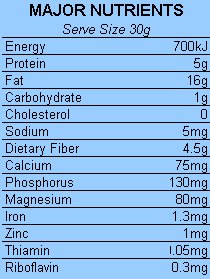Seeds and Nuts - Almonds (Prunus dulcis)

Nutritional Information
Almonds are high in oil, the oil being 87% unsaturated, mainly monounsaturated. They are an excellent source of dietary fiber, Vitamin E, and several minerals. Vitamin E acts as a natural antioxidant which helps protect the nuts from rancidity. Roasting the nuts destroys most of the Thiamin.
Description
The almond is a flat nut with pointed ends and a smooth texture. Creamy white in color, it is covered with a brown skin and is encased in a flat, pitted, light brown shell.

Origin and History
The almond has been cultivated around the Mediterranean since ancient times. The exact origin is obscure but the first trees probably grew in Turkey, and almonds have been found in prehistoric sites on the island of Crete. The almond is mentioned often in the Bible, being common in biblical lands. In the 17th chapter of the book of Numbers, the Rod of Aaron is placed in the Tabernacle by Moses and brings forth flowers and ripe almonds, signifying God's special commission to the house of Levi. The prevalence of the almond in ancient and medieval cooking is thought to be connected to religious fast days when it replaced forbidden meat and milk.
Some botanists believe that the almond cultivated today is the ancient natural hybrid of three species of wild almonds found in the arid mountains of central Asia: one, a small tree in Russian Turkestan; another, a shrubby tree in Armenia; and the third, a shrub in central Asia. It is still found wild in Algeria, in countries at the eastern end of the Mediterranean and near the Black Sea.
Cultivated almonds are the kernels of the fruit of the almond tree. Half the world's supply is cultivated in California, the rest is produced in Spain, Italy, Portugal, Morocco, Iran and Australia.
Buying and Storage
Almonds are available all year round though the crop peaks in summer and autumn. Buy nuts in the shell for maximum flavor and for longer storage. Store in an airtight container in the refrigerator or in a cool place.
Shelled and blanched almonds should be free from damage or weevil moths. Blanched almonds, whether whole, sliced, flaked, slivered, chopped or ground, are best purchased in airtight clear packaging so that the oil content is retained. Shelled nuts should be stored in their sealed package or in a glass jar in the refrigerator so that the oil content will not turn rancid.
Almond paste should be an evenly caramel colored with a firm texture, and hygienically packed in airtight clear packaging. Store in the refrigerator.
Preparation and Use
Blanch almonds to remove the skin. The simplest method is to place the almonds in a bowl, cover with boiling water and stand for 3 minutes. Pour the hot water off and cover with cold water then, by pressing the nuts one at a time - between the thumb and forefinger - the skin will slip off. Dry on a clean tea towel before use.
Almonds may be used whole, chopped, slivered or ground, in cakes, cookies, pastries, praline, confectionery and ice cream. Use whole or slivered almonds in savory or fruit salads, in casseroles, savory stuffing, savory rice, pasta dishes or nut cutlets. Use flaked almonds for cakes, cookies, pastries and decoration. Use ground almonds in place of flour for rich, moist cakes and for crisp cookies, for marzipan, to make almond paste or for thickening soup or fish and chicken casseroles.
Processing
Whole almonds are processed into halved, flaked, slivered, ground, roasted and salted forms. They are used in snack foods, marzipan, almond paste and confectionery, as well as for almond oil, liqueur and essence.
Varieties
While there are several botanical varieties of almond, the varieties which concern the consumer are: almonds in the shell; natural shelled almonds, in their skin; whole blanched almonds, with skin removed; sliced (flaked) natural almonds; sliced (flaked) blanched almonds; blanched slivered almonds; blanched chopped almonds; blanched ground almonds and almond paste - a commercial mixture of ground almonds, sugar and egg used in confectionery and baking, and for the first layer of icing on a fruit cake, underneath the royal or fondant icing.
See also: Bitter Almond









